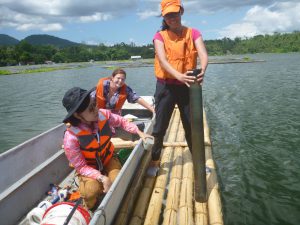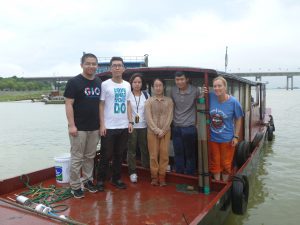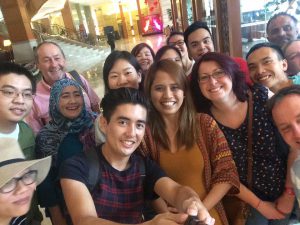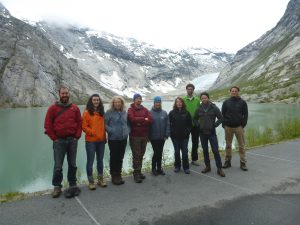
August 23, 2017, by lzzeb
The high and low latitudes of research leave
A blog by Professor Suzanne McGowan
Research leave comes to Geographers only once every six semesters, and it’s a chance to clear the backlog of half-finished papers, write grant proposals, read and think….in short do all of the things it is difficult to do whilst involved with the day-to-day tasks of teaching and administration. I had been looking forward to this for a long time, having delayed my leave for three years whilst seconded to Malaysia campus. The paper backlog was getting a little out of hand… My plan was to find somewhere quiet where I could write.
As luck would have it, the month before the start of my leave period, I received uncharacteristic but very welcome news of the success of two grant applications which were focused on research projects in Greenland and Vietnam. The reality of the mission of delivering the fieldwork for these projects alongside some pre-existing travel commitments sunk in. I dug out my passport, bought a couple of heavy duty suitcases and set off on mission impossible, leaving the paper backlog to pray on my mind whilst I travelled between 7 countries on 5 field trips, and 3 scientific meetings.
First up in February was a trip to Kuala Lumpur where we were hosting a meeting of PAGES Aquatic Transitions working group at University of Nottingham Malaysia Campus. This included a workshop with a focus on Southeast Asia-Oceania and a Mindset public lecture, which can be accessed by podcast here. This was shortly followed by a trip to the ASLO (Association for the Sciences of Limnology and Oceanography) conference in Honolulu where I presented in the Aquatic Transitions session- here’s a photo of the speakers for the session.
There were a couple of trips to Greenland that needed to be squeezed in for the new research project which was looking at the impacts of glacially-derived dust on Arctic lakes. The work is summarized in blog articles describing work in April whilst the lakes were snow covered when we were looking at accumulations of dust in the snowpack, and then again in June once the ice had melted, when we could set up experiments and sample the lake waters to understand the impacts of the dust.

Students (from L to R) Christina Chen, Charlotte Briddon and Letisha Fong collecting sediment cores in the Philippines
In warmer parts of the world I spent a week in May helping my PhD student Charlotte Briddon sediment coring in lakes on Luzon Island in the Philippines. The cores will form a key part of her research project, looking at aquaculture impacts in these lakes, and the work was supported by students from University of Santo Tomas in Manila and National University of Singapore who captured some stunning drone images over the lakes. We also spent 10 days in July along the Red River Delta, as part of a NERC-NAFOSTED funded project. The trip involved fieldwork to collect water and sediment samples (blog article here), meeting with our Vietnamese partners and establishing contacts with local stakeholders.

PhD student Linghan Zeng (L) with researchers from the China University of Geosciences on Dongting Lake
I had been planning a visit to the China University of Geosciences in Wuhan for a while, to work with a good collaborator and former postdoc at Nottingham, Dr Xu Chen. We planned to conduct some fieldwork on the Yangtzse River to support my PhD student Linghan Zeng– a very successful trip to Dongting and Hong Hu Lakes in the mid reaches of the Yangtzse to collect sediment cores and water samples. We also found the time to work on some new papers, and finish off the revisions on some others we had been working on; here is a link to one recently published in Hydrological Processes. I also gave a seminar entitled Lakes and the Arctic Carbon Cycle.
Otherwise, it was proving tricky to clear some time for paper writing, but I attended a workshop in May which was geared to do just that. The KAIRN group (Kangerlussuaq International Research Network) meets annually as a forum for exchanging ideas with researchers from across disciplines who work in this area of Southwest Greenland. We recently published an article in Bioscience from previous workshops, and this year we met in Norway to work on a follow up paper. The setting in Sogndal along a stunning fjord and close to the Norwegian Glacier Museum made for some breathtaking field visits after the workshop.
So….how is the paper backlog doing at the end of this six months of research leave? Well, I found a few weeks to finish off the revisions on a long-standing paper looking at diatoms in West Greenland. Some of the research in this paper was conducted by one of our undergraduates Hazel Gunn who was a Royal Geographical Society fieldwork apprentice in 2010. It was great to see this work, which formed a part of Hazel’s final year dissertation finally out in print. On balance, the field trips probably generated more papers to write than I cleared off the desk, but I can’t complain too much- mission impossible is complete.
No comments yet, fill out a comment to be the first



Leave a Reply